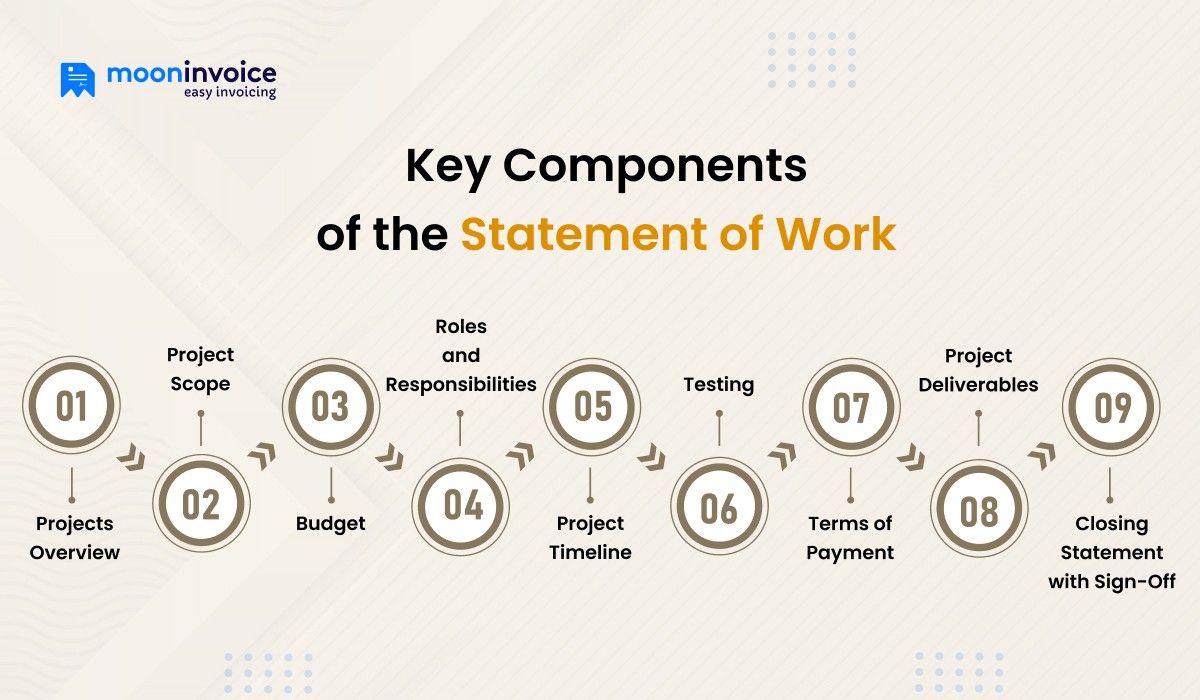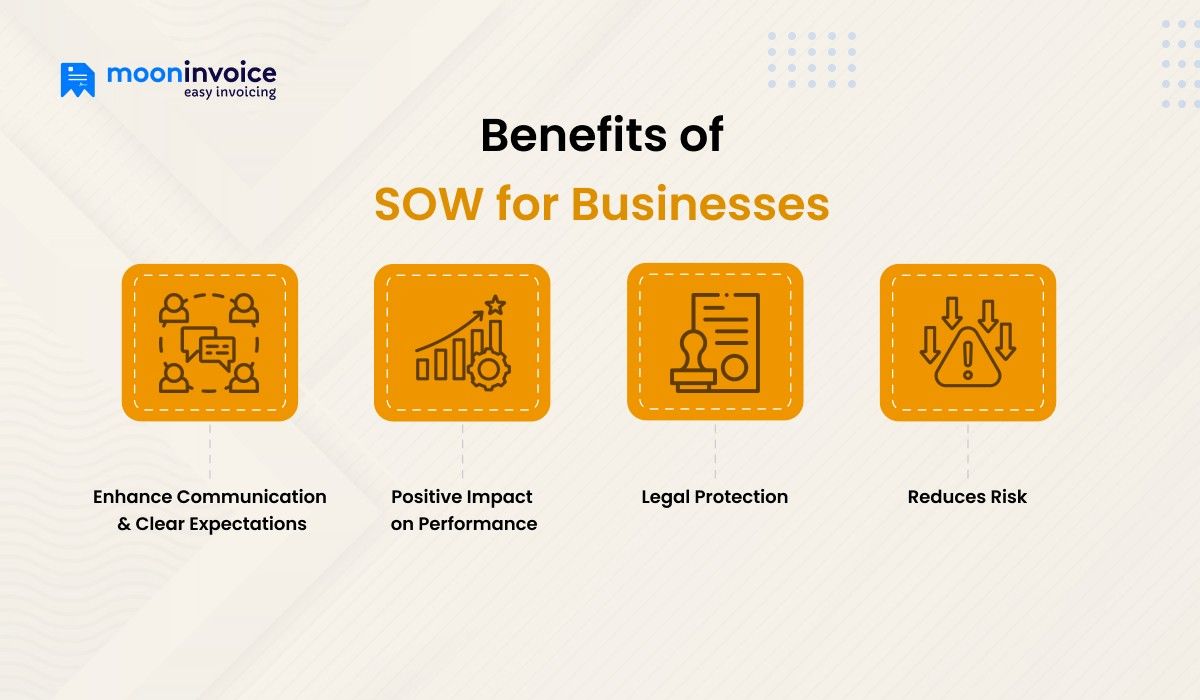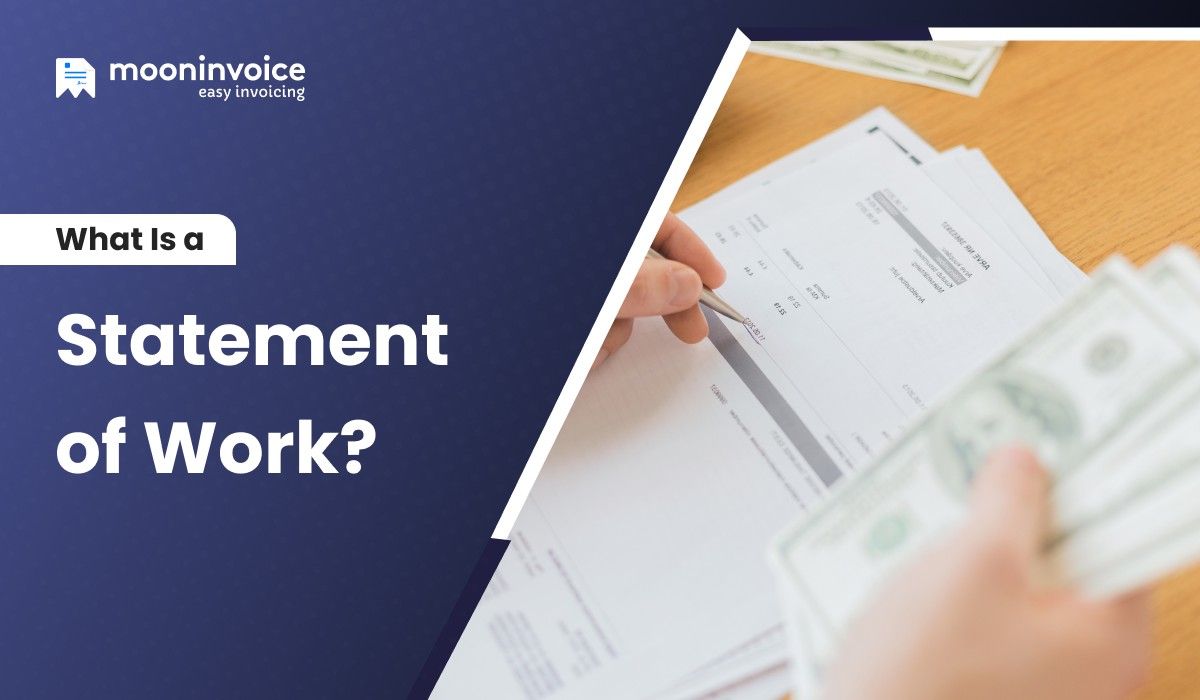Before initiating any project, professionals need to establish several key factors. Additionally, it is essential to establish clear communication between you, as the service provider, and your client throughout the entire project management process.
One of the easiest approaches to the above statement is to use a statement of work that defines a document outline and project details. Thus, there is clarity and a smooth flow of all project tasks, while keeping confusion at bay.
This is a brief introduction, but we will outline the entire story of what a statement of work is. Further, you’ll find its examples, types, and an approach to writing an SOW.
📌 Key Takeaways
- A statement of work document acts as a legally binding agreement when incorporated into a contract & signed by the two parties.
- A well-defined SOW covers every detail of the project, including scope, timeline, milestones, payment terms, acceptance criteria, & other detailed plans.
- A statement of work in project management is useful for legal protection.
- An SOW defines the work and responsibilities of all the individuals involved in the project.
- Following the correct SOW helps to complete the particular project & improves business relationships with the client.
📊Knowledge Nugget:
The global project management software market is projected to reach USD 20,469.8 million by 2030.
What Is a Statement of Work?
A statement of work in a business is a formal document that carries all the details related to the project execution. It outlines the project’s scope, schedule, estimate, payment terms, and other relevant criteria. SOW serves as a legal agreement between the parties (the service provider/vendor and the client) when used in conjunction with a contract.
SOW in project management is created after understanding the client’s needs. Thus, it is essential to set a proper and open communication with the client before writing the SOW.
The primary purpose of a statement of work in project management is to keep all project team members aligned and informed. It reduces confusion and misunderstanding during the project, thereby helping to minimize risks and maintain a smooth project flow. Additionally, it improves the vendor payment process.
What Are the Key Components of the Statement of Work?

After understanding what an SOW is, let’s define its components. Multiple components are essential to consider when creating a comprehensive statement of work document. An SOW consists of the various key elements, which are as follows:
Projects Overview
The SOW document includes the project’s overview and objectives. The details highlight what the project is about with complete project life cycle details.
Project Scope
It encompasses the materials and processes used in the project. The expected outcomes and timeline of the project are also outlined in this section and must be clearly defined.
Budget
Regardless of whether you manage expenditures manually or use expense management software. The SOW should include every crucial detail of the project’s expenses and overall budget.
Roles and Responsibilities
The project statement of work will also define the roles and responsibilities of the project members for specific tasks. It bifurcates the roles of each member, defining who will do which work. It outlines the skills, expertise, and resources required by the team to meet the project’s milestones.
Project Timeline
This component represents the project’s timeline. It states the project’s start date and end dates. Additionally, it’ll include the time it takes to achieve milestones in larger projects for specific tasks.
Testing
Before the project is delivered, if testing is required, it should be specified in the statement of work. The key details to include are how testing will be conducted, who will perform the testing, and what equipment will be required for the testing.
Terms of Payment
SOW should include the terms & conditions related to the payment. For instance, if net 30 payment terms are applicable, they should be included in the SOW.
Project Deliverables
The document will include a detailed list of tangible and intangible products and outputs that the service provider is required to produce. This serves as proof of successful work completion.
Closing Statement with Sign-Off
The final component is a closing statement that presents the conclusion, including the names and signatures of the involved parties.
Manage Your Projects’ Billing Process With Moon Invoice
Simplify your project’s billing with professional invoice templates. Digitalize billing and ensure accuracy!
How to Write or Create a Statement of Work?
Creating a statement of work is not a difficult task. However, you must have a client meeting and understand the requirements and the project’s purpose well before making an SOW.
Here are the step-by-step guidelines for creating it
1. Initialize with Clear Objectives
Start the SOW through the initialization of writing objectives. Define the project’s summary or objective, providing a clear understanding of what the project is about and its intended purpose. In short, mention the major purpose statements of the project development.
2. Mention Projects Timeline
Include the project’s schedule and timeline according to which the project will be managed. Clearly bifurcate the timeline and specify the deadlines under which project milestones must be achieved.
3. List Out Deliverables
What the project will deliver as an outcome of the project (tangible or intangible). You must specify the quality, quantity, and timing as part of a statement of work for project management.
4. Mention the Required Resources
List out what resources you need during the project. Give the details of the material, software, or hardware required during the project in the form of resources.
5. Project Budget
Include what the total budget of the project will be and what expenses it will incur. Provide a detailed and cost breakdown structure for a better understanding.
6. Define Roles and Responsibilities
Clearly mention the roles of every project member involved in the project development. The statement & details must be clear about who will do what.
7. Includes Terms of Payment
What will be the payment terms, according to which the client needs to make payment & what will be the mode of payment? It must specify whether the service provider requires an upfront payment or a full payment. Write out every term in an easy, understandable language.
8. Signature
Include the signature of the involved parties to authorize the SOW agreement. It should also include the names of the clients, service provider, and other stakeholders.
Not Able to Track Accurate Billable Hours?
Moon Invoice is the right solution! Simplify tracking billable hours and ensure invoice collection for every project.
Statement of Work Example
We have defined the answer to the question: What is SOW in project management? Now, understand it well through a statement of work example. Here we are considering the website design and development project for a furniture manufacturer named “MapleStone Furniture.” So, the typical flow will be as follows:
Introduction
A website design and development project for “MapleStone Furniture.” The project will be managed by Infosystem Pvt Ltd, which is responsible for handling all end-to-end project activities. The primary purpose of the project is to fulfill all the client’s requirements while creating the website, thereby adding value to the client’s business.
Project Objective/Overview
The primary objective of the project is to design and develop a responsive business website for MapleStone Furniture. It should encompass both the user experience and brand visibility. Also, integrating the e-commerce functionality.
Scope of Work
The project involves designing five web pages and setting up an e-commerce module. The process will also include setting up the SEO setup and analytics integration. The process will not include content creation or any other SEO related activities for the website.
Budget & Expenses
- Domain & hosting charges
- Design and branding charges
- Plugins and tools charges
- Maintenance & support charges
- Additional charges
💡Check This Out:
Project Deliverables
All the client-approved designs and wireframes, along with the fully responsive website, were integrated with an e-commerce module.
Timeline & Schedule
The schedule of the different project phases will be as follows:
| Milestone | Due Date |
|---|---|
Roles & Responsibilities
- Client: To provide content and feedback on every shared milestone.
- Service Provider: To deliver the design, development & testing per scope.
- Project Manager: To monitor every progress of the project and continuously update the client.
Payment Terms
- 30% of the total cost will be applicable for the upfront payment & advance invoicing.
- 40% of the total cost on delivery of the beta version.
- 30% of the total cost is on the final delivery of the project completion.
Acceptance Criteria
The acceptance criteria will cover the checklist of designs, functionality, performance, and security. The client needs to review all the points and sign them to indicate approval and agreement.
Approvals name and Signature
Client’s Name [Signature]
Service Providers Name [Signature]
Types of SOW
So, after defining what an SOW is, we now determine its types. There are three types of statement of work documents, which are as follows:
1. Design & Detail Statement of Work (SOWs)
This type of project statement of work includes detailed information on the project. The format is usually for construction projects and manufacturing products. It contains all the detailed information related to the project, including the required materials and dimensions, as well as the project’s deadlines.
2. Level of Efforts SOW
The major focus of this type of SOW in project management is on the time and resources required for the project. This type of document is primarily useful for services where the work is defined by the time and effort invested in the task. A time tracking software is crucial to manage such SOWs.
3. Performance-Based SOW
A performance-based sample statement of work primarily focuses on the output, regardless of the payment method used to achieve it. It does not include how the work is to be accomplished. Vendors can freely utilize their expertise and the preferred method. It includes a performance-based statement.
Statement of Work vs Scope of Work
A common mistake in business project management is confusing the statement of work with the scope of work. However, there is a great difference between these two.
The SOW provides detailed information from the introduction to the final project closure. However, the scope of work refers to a specific part of a large-scale project that outlines the work that will be done within the project.
Statement of Work vs Master Services Agreement (MSA)
The statement of work mainly consists of the project’s related details and is narrow in its structure. In contrast, a master services agreement (MSA) is a long-term contract that encompasses a broad scope and defines the legal and business terms between the parties. Its major focus is on the legal and compliance aspects.
Statement of Work vs Services Procurement
The statement of work is a project’s detailed documentation that defines the project’s scope, timeline, deliverables, and payment structure. Service procurement is a buying process that encompasses sourcing, purchasing, contracting, and managing external services from contractors. SOW is a document that defines the exact terms of the purchased service.
💡Get Insight into:
Benefits of SOW for Businesses & Projects

A statement of work in project management is very helpful in streamlining the project flow. Here are the points that justify why SOW is important for the project.
Enhance Communication & Clear Expectations
A well-documented SOW improves communication between all the stakeholders while binding them all through a single reference documentation. It reduces confusion because every detail is clearly outlined in the document, keeping all involved members on the same page.
Positive Impact on Performance
SOW defines the outlines, roles, and responsibilities of every project team member. This ensures the process runs smoothly. Additionally, it clearly defines the required resources and staffing. This proper allocation ensures better productivity, which ultimately enhances performance.
Legal Protection
The SOW serves as a formal agreement between the parties, streamlining the legal process. It provides a clear and detailed reference point in case of disputes and conflicts.
Reduces Risk
Since everything is well-structured in the SOW, there are fewer chances of confusion. It also reduced financial losses by ensuring clarity, enforceability, and accountability.
No More Hassle for Your Project’s Expense Management
Incorporate the digital power of Moon Invoice to simplify your project expenses. Save time & speed up your work!
Key Challenges and Risks of SOW
The following are some challenges & risks associated with the statement of work document.
- Incomplete information that does not present enough detail.
- The timelines and milestones were poorly defined.
- Legal and compliance issues.
- Creating a restrictive SOW that does not allow flexibility can lead to conflicts.
- Lack of realistic deadlines or the missing checkpoints.
- Missing clarity over KPIs or acceptance criteria.
4 Pro Tips for Managing the SOWs Process
By adopting the following tips, you can effectively manage your SOW process. These tips help to streamline the flow:
1.Mention Every Detail With Clarity
Service providers should be aware of the language, clarity, and correctness of the details. Keeping the language simple and professional enhances clarity. A well-written statement reduces misunderstandings.
2.Using a VMS or Project Management Tool
Professionals can simplify their statement of work management by utilizing the vendor management software. It enhances the vendor-client relationship by providing a unified platform to manage all aspects of the entire relationship. Professionals can easily understand & manage their sales, estimates, overdue, and outstanding payments.
3.Work Breakdown Structure
Representing tasks with deadlines in a breakdown flow enhances the clarity & understanding. Moreover, it is helpful in tracking progress and managing risks. Therefore, it is a good practice to present tasks in an itemized form.
4.Reviewing Details
Cross-checking the SOW document is another crucial tip to follow. A project manager must review the details to ensure that no shortcomings or mistakes are left out in the crucial document. A single mistake or shortcoming can ruin the project management process, and reviewing is the best way to prevent it.
Moon Invoice to Streamline Your SOW Process
Incorporating tools like Moon Invoice is another way to revamp your SOW process. One of the best invoicing tools that offers a small business invoice template to generate digital invoices to mirror your SOW milestones.
Additionally, the tool offers a time tracking feature to track your project’s billable hours accurately for time and material-based SOW. Business professionals can track their project time accurately with no extra effort. This keeps the client’s payment aligned with the work agreements.
The tool serves as a single platform to store and manage all SOW documents like estimates, invoices, and receipts. It helps prevent mismanagement and keeps everything in a systematic frame.
Last Remarks
A statement of work is not just a document, but an approach to keep your projects aligned with good performance and a smooth flow. It helps businesses keep their project processes active, set clear goals, and meet deadlines. Additionally, the document helps improve client-vendor relationships.
Moon Invoice is the right place to streamline your project management. Manage everything, including project time tracking, project tasks, expense tracking, and invoicing, all on one platform with the right accuracy & speed. Eager to know how much it costs? Find Moon Invoice pricing.



















